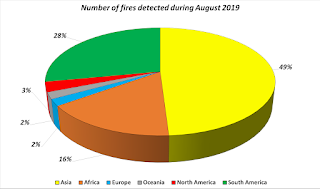Longer, More Frequent Fire Seasons. A new analysis of 35 years of meteorological data confirms fire seasons have become longer. Fire season, which varies in timing and duration based on location, is defined as the time of year when wildfires are most likely to ignite, spread, and affect resources. In the map above, areas where the fire season lengthened between 1979 and 2014 are shown with shades of orange and red. Areas where the length of the fire season stayed the same are yellow. Shades of blue show where the fire season grew shorter. Gray indicates that there was not enough vegetation to sustain wildfires...Read more.
Longer, More Frequent Fire Seasons. A new analysis of 35 years of meteorological data confirms fire seasons have become longer. Fire season, which varies in timing and duration based on location, is defined as the time of year when wildfires are most likely to ignite, spread, and affect resources. In the map above, areas where the fire season lengthened between 1979 and 2014 are shown with shades of orange and red. Areas where the length of the fire season stayed the same are yellow. Shades of blue show where the fire season grew shorter. Gray indicates that there was not enough vegetation to sustain wildfires...Read more.
Is Earth on fire? Wildfires have been making headlines again this month, with multiple fires burning in Lebanon and California, but these are just some of the many fires 2019 has seen. Fires in the Amazon sparked a global outcry this summer, but fires have also been blazing in the Arctic, France, Greece, Indonesia as well as many other areas in the world. Quantifying and monitoring fires is important for the ongoing study of climate because they have a significant impact on global atmospheric emissions, with biomass burning contributing to the global budgets of greenhouse gases, like carbon dioxide.... Read more
A Forest Expert Team In Spain Fights Fire With Fire — Literally. Fires in California and the Amazon rainforest have grabbed attention, but large areas of Europe's forests also were consumed this summer. Blazes nearly the size of the one in Catalonia tore through Spain's Canary Islands, the south of France and the Greek islands of Evia and Samos.
"We need to learn to live with fire, the same way we do with tornadoes or snowstorms", says Marc Castellnou, chief analyst for a special forest unit of Catalonia's fire services, known by its Catalan initials GRAF... Read more

What California Stands To Learn From Indigenous Fire Management Practices. For 13,000 years, many Indigenous tribes, including the Hupa, Karuk, Miwok, and Yurok lit controlled fires across northern and central California. This created a mosaic of habitats with a high diversity of species that California is known for today. Through multiple progressions of these practices, many species, such as acorns and huckleberries became associated with these deliberate, low-intensity fires. Despite their fire resistance, they are ill-equipped to tolerate the high-intensity nature of modern wildfires in California... Read more
Policy Developments and Outlook
Fire in Yellowstone. Fire has been a key factor in shaping the ecology of the Greater Yellowstone Ecosystem. Native plant species evolved adaptations so they survive and, in some cases, flourish after periodic fires. Fire influences ecosystem processes and patterns, such as nutrient cycling and plant community composition and structure. Fire regimes in the western United States changed with the arrival of European and American settlers, whose livestock removed grassy fuels that carried fires and whose roads fragmented the continuity of fire-carrying fuels. Most naturally occurring fires were suppressed to the extent possible. The National Park Service aims to restore fire’s role as a natural process in parks when and where this is feasible... Read more



No comments:
Post a Comment